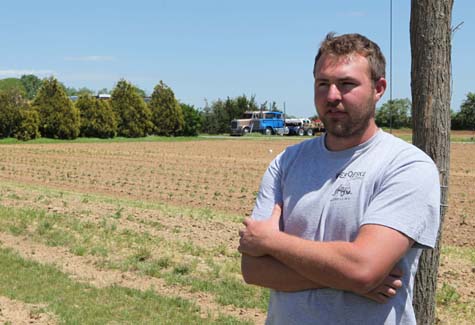Hops: One young North Fork farmer’s unique crop

As the local-food trend began to take firm root on the North Fork, a young farmer-turned-brewer in Peconic decided this spring to make his mark on the movement.
He started by asking a landscaper friend for nine 23-foot high locust poles, which, using his family’s tractor and an elaborate pulley system, he buried seven feet into the ground on his family’s farm on Route 48. He then rigged a series of cables and winches to each pole, 16 feet above the ground, and readied himself for planting, while drivers in cars whizzing down the highway scratched their heads in wonder at his contraption, which looked like they had been readied for a trapeze artist’s training grounds.
Justin Wesnofske, 23, had been helping out on his family’s farm since he was a child. When he came home from college last year in the midst of the economic meltdown with a degree in criminal justice, he heard about the Greenport Harbor Brewing Company, which had just opened in Greenport. He decided to take a gamble and switch career paths, and he’s been managing the brewery’s accounts, which now number about 125, ever since.
But the farmer in him knew there was more he could do to help his new company. He wanted to provide an ingredient that gives each beer its unique taste. He wanted to grow hops.
In April, after months of studying YouTube videos and internet resources on growing hops, he received a box of 300 rhizomes of three different varieties of hops, whose nugget-like cones provide the citric bitter taste in beer, from a supplier in Oregon. The rhizomes looked like little sticks. A YouTube video had said they would grow to be 25 feet tall. Mr. Wesnofske was doubtful.
“My father thought we were crazy,” he said as he showed off Wesnofske Farms’ new hop field while his father, Eugene Wesnofske plowed a field in the distance. “Originally, he was thinking this was going to be another headache. But this definitely broadened our horizons. A lot of people are stopping by and saying ‘what are you guys doing?’”
By the first week in June, some of the hops plants were nearly a foot tall. In the heat of summer, they will likely grow an inch a day. Within weeks, Mr. Wesnofske plans to attach long cables to the posts and train the hops to reach for the heavens. And the brewery owners are thrilled.
“We’d love to be able to use every single product that’s locally grown,” said Greenport Harbor Brewing Company co-founder Rich Vandenburg. “That’s the cat’s meow aspect of the business, being able to continue the pursuit of fresh, well-made local product on the North Fork.”
Mr. Vandenburg said the brewery had explored growing barley locally in the past, but there are no barley malters on Long Island, and growing the barley here and having it shipped to Massachusetts to be malted, wasn’t economically feasible.
“Malting is definitely a specialty type of process,” he said. “It’s one industry that isn’t readily available to us on the island. It’s a whole separate and individual process of soaking the grain until it’s just about to sprout, kiln drying and monitoring sugar content. It’s a time consuming, tedious artisanal process.”
Back on his family’s farm, Mr. Wesnofske explained that he had picked out three varieties of hops. Two of the varieties, called Centennial and Nugget, were ones that Greenport Harbor Brewing Company had already used in their brewing process, though in a pelletized form. The third variety, Santiam, is a new type of hop that hasn’t been widely used in commercial production.
The Greenport brewers have a while to wait before they know they’ve got a good crop. Hops grow to 25 feet tall their first year, but don’t begin to produce cones until the second year, though the plants will bear fruit for 15 to 20 years from then on.
They’re hoping to hold a hop festival in September 2012 in conjunction with the first ripening crop, at which they’ll brew a special “fresh hop” beer.
“They say each plant will produce one to three pounds of hops when fully mature,” said Mr. Wesnofske. “We’re going to kick back, have some beers, have a barbecue, pick some hops and call it a day.”








